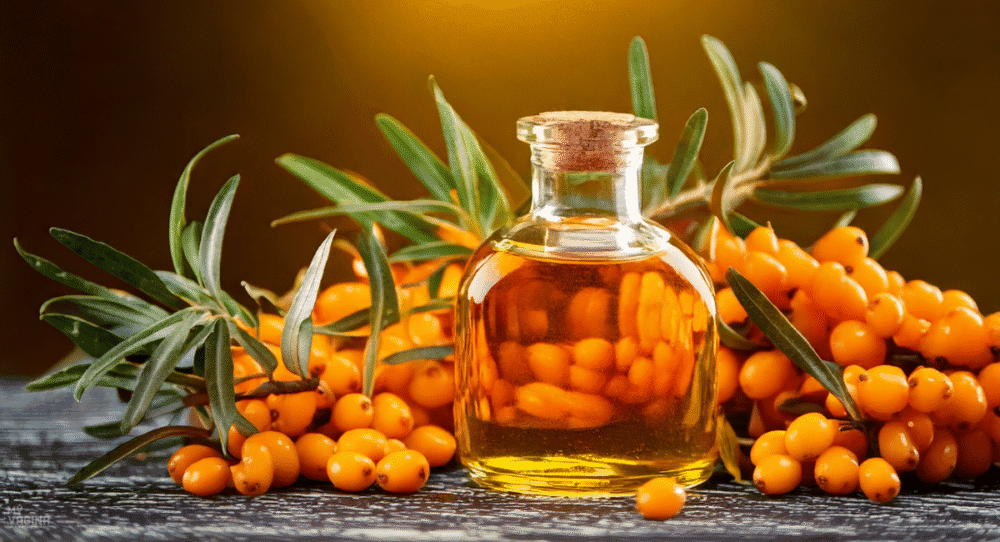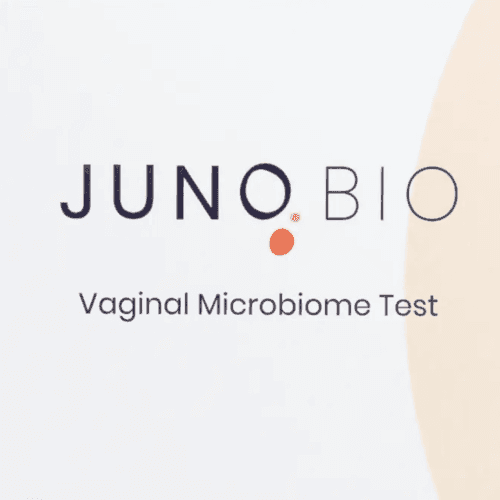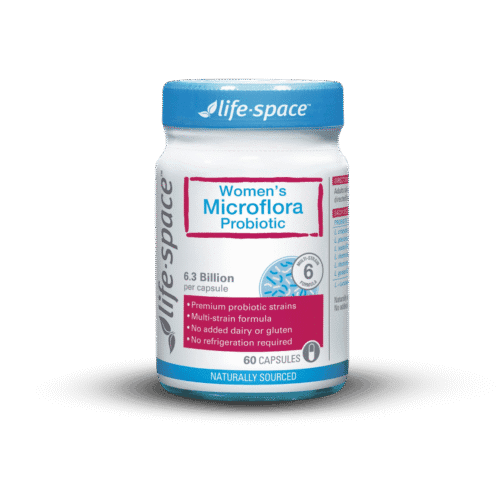Vaginal dryness, irritation, and tissue fragility are common when oestrogen is very low or absent.
Postmenopause, perimenopause, breastfeeding, and medicines such as tamoxifen or aromatase inhibitors used after breast cancer can all reduce lubrication, elasticity, and resilience in vaginal and vulvar tissues.
These changes are part of what doctors call genitourinary syndrome of menopause (GSM), formerly known as atrophic vaginitis. However, similar symptoms can occur at any age when oestrogen is suppressed.
Hormonal treatments can help with GSM and vulvovaginal symptoms, but they are not for everyone. Whether on hormonal treatments or not, non-hormonal strategies can be an important part of restoring moisture and function to vaginal tissue.
One of the most promising ingredients for restoring vaginal moisture is sea buckthorn (Hippophae rhamnoides) oil, extracted from both the berry’s fruit (pulp) and its seeds. These two oils differ in their fatty acids, antioxidants, and effects on tissue.
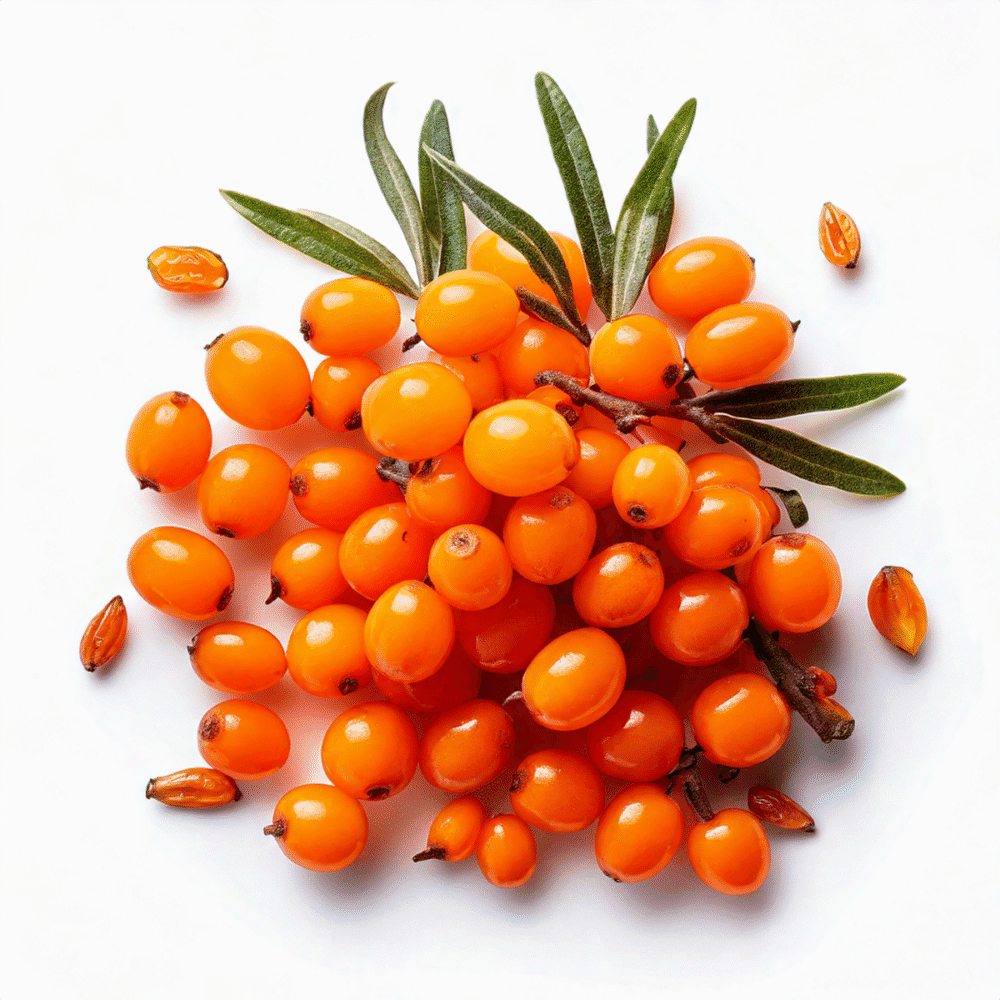
This article explains what each element of the oils does, and how each can be used orally, topically on skin and intravaginally. We’ll also go through what the research shows about safety and effectiveness in low-oestrogen states, including for those on tamoxifen or other oestrogen-blocking drugs.
What is sea buckthorn, and why is it relevant to vaginas?
Sea buckthorn is a scrubby plant that produces bright orange berries containing our prized oils. The seeds are contained inside the berries, nestled into the pulp.
The sea buckthorn fruit oil and seed oil each have a characteristic biochemical profile that maps to different clinical uses. The primary uses for these oils are healing and improving skin, anti-ageing, and supporting mucosal surfaces like the vagina.
In the low oestrogen vagina, restoring the fatty (lipid) barrier and reducing irritation are key goals. Sea buckthorn’s rare omega-7 fatty acid profile (from the fruit) and its essential omega-3 and omega-6 fatty acids (from the seed) together offer a rational, non-hormonal treatment to improve vaginal comfort and promote healthy tissue.1–4
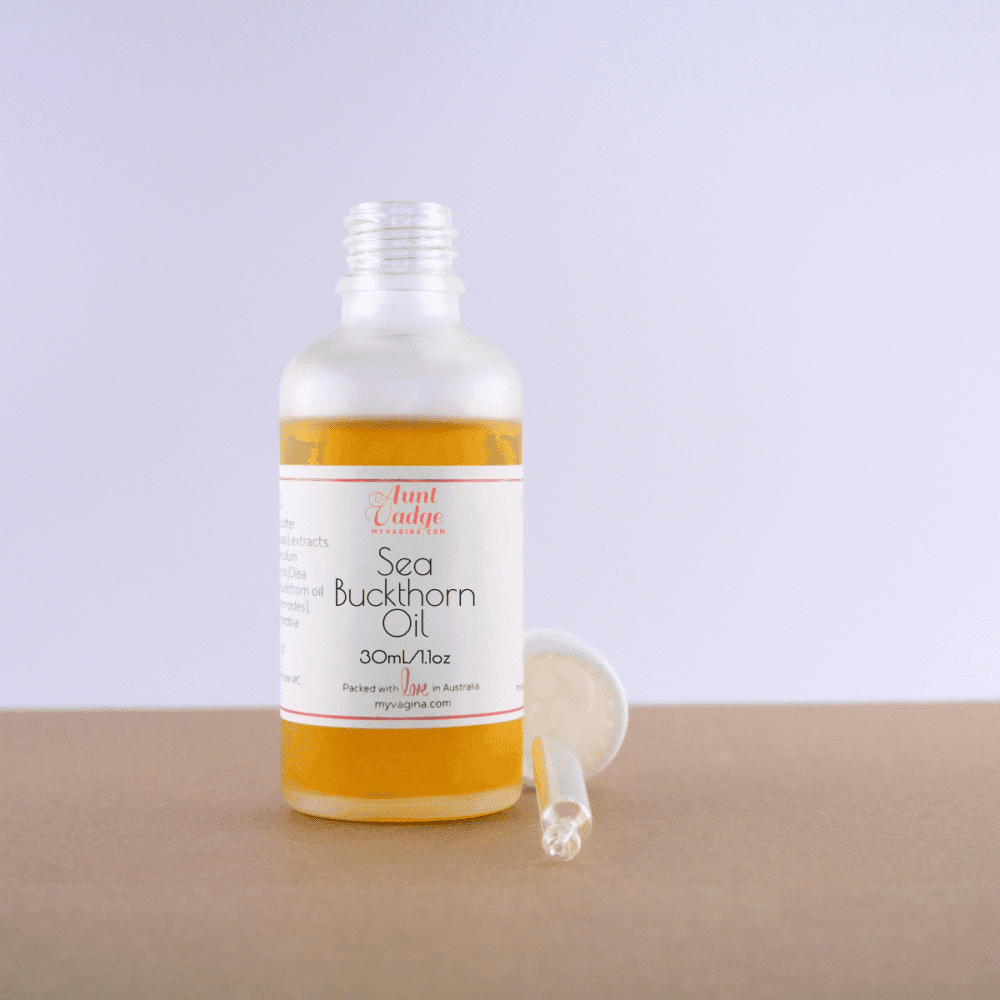
The vaginal mucosal barrier and lipid layer
One of the vagina’s protection systems is the mucosal barrier. It isn’t just one layer — it’s a dynamic combination of mucus, lipids, microbes, and epithelial cells working together to keep the tissue hydrated, elastic, and resistant to infection.
This barrier system depends on oestrogen to stay balanced and well-lubricated. When oestrogen levels fall (in menopause, postpartum, or during treatment with oestrogen-blocking medicines like tamoxifen) the mucosal surface becomes drier and more fragile, the pH rises, and less-protective microbes can move in.
Within this system lies the lipid barrier — a thin layer of natural fats that coats the upper surface of the vaginal lining, much like a light, oily seal on top of a sponge. You can’t see it or feel it, but it’s in there. These lipids act as part of the mucosal defence system, helping to:
• Lock in moisture by slowing water loss from the surface
• Protect the delicate epithelial cells from friction and irritation
• Maintain a stable environment for beneficial Lactobacillus bacteria to thrive
• Form part of the defence line that keeps out harmful bacteria and their toxins
What is the vaginal lipid barrier?
The main components of this lipid film — fatty acids, ceramides, and cholesterol — are the same types of fats that keep skin supple and hydrated elsewhere on the body. The lipids create a flexible, breathable seal that preserves the vagina’s moisture and resilience.
Below the lipid layer, the epithelial tissue continually renews itself, producing mucus and shedding old cells as part of the vagina’s maintenance process. This constant renewal relies on healthy lipid production and adequate hydration to prevent fragility and microtears.
Supporting both the mucosal and lipid barriers with omega-rich oils — such as sea buckthorn fruit and seed oils — can help restore comfort and moisture balance over time. These oils supply the essential fatty acids that reinforce the natural lipid layer, nourish the epithelial cells, and strengthen the vaginal ecosystem from both inside and out.
Fruit versus seed oils: what is the difference?
Sea buckthorn fruit oil’s rare fatty acid profile
The fruit or pulp oil contains a high proportion of palmitoleic acid, a rare omega-7 monounsaturated fatty acid found naturally in skin and mucosal secretions.
In many analyses, palmitoleic acid makes up roughly one-quarter to two-fifths of total fatty acids in the pulp oil.
This unusual composition is thought to underpin fruit oil’s effects on softness, hydration, and epithelial repair.1,4
Sea buckthorn seed oil fatty acid profile
The seed oil is rich in polyunsaturated essential fatty acids, especially linoleic acid (omega-6) and α-linolenic acid (omega-3), often in a balanced ratio. These lipids are core components of cell membranes and precursors for anti-inflammatory mediators.
Seed oil contains little omega-7 but contributes strongly to barrier repair and systemic lipid balance.1
Antioxidants, sterols, and the amazing orange pigments
Fruit oil is intensely coloured (pigmented) because of carotenoids such as β-carotene (in carrots) and lycopene, alongside tocopherols (vitamin E) and plant sterols.
These provide antioxidant protection to delicate tissues and may aid healing. Seed oil also carries tocopherols and sterols, though with less pigment than the fruit fraction.5
Physical properties and stability
Fruit oil is thicker, more viscous, and intensely orange – yes, it stains clothes! Seed oil is lighter and less thick.
Both are sensitive to oxidation because of their unsaturated fats, so cold pressing, dark glass, antioxidant stabilisers, and cool storage are all quality markers.
Why low oestrogen leads to dryness – and where sea buckthorn fits
What happens when oestrogen falls
Oestrogen supports vaginal epithelial thickness, glycogen content, blood flow, and the lipid matrix that retains moisture.
When oestrogen levels drop or are blocked, the epithelium thins, elasticity falls, pH rises, and microtears and burning become more likely.
These changes combine to cause dryness, irritation, and pain with sex for many people post menopause and for those taking oestrogen-blocking medicines such as tamoxifen or aromatase inhibitors.
How the two oils map to vaginal needs
• Fruit (pulp) oil – omega-7 (palmitoleic acid) helps rebuild the mucosal lipid layer, supporting hydration, softness, and epithelial regeneration.
• Seed oil – omega-3 and omega-6 fatty acids support membrane structure and provide anti-inflammatory precursors, helping to stabilise and protect tissues.
Because mucosal health depends on multiple factors, using both oils is logical: fruit for surface lubrication and repair, seed for structural and anti-inflammatory support.
What the evidence says
Oral supplementation
The best-known clinical trial2 is a randomised, double-blind, placebo-controlled study in postmenopausal women with vulvovaginal symptoms, where participants took 3 g/day of sea buckthorn oil for three months.
Compared with placebo, those taking sea buckthorn had a statistically significant improvement in vaginal epithelial integrity and a favourable trend in a composite vaginal health index (a scoring system).
The effect size was modest rather than dramatic, and not all secondary measures changed significantly. Still, the findings suggest a supportive role for oral sea buckthorn in maintaining mucosal integrity when oestrogen is low.
Subsequent studies have explored systemic moisturising effects on skin and other mucosae, with some reporting improvements in dryness symptoms, though methodologies and formulations vary.3
Overall, oral sea buckthorn appears safe and may provide incremental benefits over weeks to months, especially when both fruit and seed fractions are included.
Local (vaginal or topical) application
Local use directly on vulvar skin or inside the vagina delivers lipids directly to the target tissues.
Small clinical studies report improvements in vaginal dryness, burning, itching, and atrophic appearance when formulations containing sea buckthorn oil are applied intravaginally or topically, sometimes alongside hyaluronic acid.
A study of a vaginal cream combining sea buckthorn oil with hyaluronic acid reported symptom improvement and healthier mucosal appearance over several weeks.6
While the numbers are small, these results are consistent with the mechanism: replenishing the lipid barrier and protecting the vaginal epithelium.
Because raw oils can irritate some users, well-designed vaginal formulations typically blend sea buckthorn oil with suitable carriers, emulsifiers, and buffers. Patch testing and cautious first use are sensible, especially on fragile tissues.
Breast cancer survivorship and oestrogen-blocking medicines
Sea buckthorn oils have no known oestrogenic activity. Oral and local use are generally considered non-hormonal, which is relevant for people on tamoxifen or aromatase inhibitors.
However, survivorship care is individual.
Oncologists often prefer products with minimal systemic absorption when addressing vaginal symptoms, and data specifically in drug-induced low-oestrogen states remain limited. Personalised discussion with the treating team is always recommended.2
Oral versus local use: choosing and combining
When to consider oral supplementation
• When dryness affects multiple mucosal surfaces (vaginal, oral, ocular) and the goal is systemic support.
• When consistent daily dosing is easier than local application.
• When the product contains both fruit and seed fractions to include omega-7 and essential fatty acids.
Typical research dosing is approximately 2–3 g/day of sea buckthorn oil for 8–12 weeks.2 Real-world dosing should reflect the actual composition on the label; not all products specify fruit versus seed ratios.
When to consider local (vaginal or topical) use
• When the primary symptom is vaginal dryness, irritation, or pain with sex.
• When faster local relief is desired or systemic dosing is not tolerated.
• When a suitable intimate formulation is available, ideally pH-considerate and non-irritating.
Start with small amounts 2-3 times per week and adjust. Expect harmless staining from carotenoid-rich fruit oil fractions. If irritation occurs, pause use and reassess formulation choice and frequency.
Practical guidance
Quality markers to look for
• Clear labelling of fruit (pulp) versus seed content, or a blended formulation that specifies both.
• Cold-pressed or supercritical CO₂ extraction.
• Dark glass packaging, antioxidant stabilisers (for example, mixed tocopherols), and cool storage after opening.
• For intimate products, attention to pH, excipients, and potential irritants.
Who might consider sea buckthorn oil
• People with vaginal or vulvar dryness in menopause, perimenopause, postpartum, or on oestrogen-blocking therapy.
• Those seeking non-hormonal options or adjuncts to moisturisers and lubricants.
• Individuals with dryness across multiple mucosae who want systemic lipid support.
Who should be cautious
• People with known sensitivities to botanical oils or excipients.
• Those on complex medication regimens – discuss supplementation with your healthcare team.
• Anyone with persistent pain, bleeding, or recurrent infections – seek medical assessment to exclude other causes.
Limitations and research gaps
• Few large, long-term randomised trials specifically in users of tamoxifen or aromatase inhibitors.
• Variable product compositions and extraction methods make cross-study comparisons difficult.
• Unclear dose–response relationships for fruit versus seed ratios.
• Limited head-to-head comparisons of oral versus local delivery on patient-centred outcomes.
Despite these gaps, the current evidence base and plausible mechanism support sea buckthorn as a sensible non-hormonal option for many.
Tips for choosing sea buckthorn oil
• Fruit (pulp) oil is rich in omega-7 and supports mucosal hydration and epithelial repair.
• Seed oil is rich in essential omega-3 and omega-6 fatty acids and supports membrane structure and anti-inflammatory balance.
• Oral use offers systemic support over weeks to months; local use targets symptoms directly and may act faster.
• Combining fruit and seed fractions can deliver complementary benefits in low-oestrogen states, including in people taking tamoxifen.
• Choose well-made formulations and tailor dosing and application to symptoms and tolerance.
Sea buckthorn oil FAQ
Fruit (pulp) oil is rich in omega-7 (palmitoleic acid) and carotenoids that support mucosal hydration and epithelial repair.
Seed oil is rich in essential omega-3 and omega-6 fatty acids that support membrane structure and anti-inflammatory balance.
They are complementary, not interchangeable.1,4
Sea buckthorn oils have no known oestrogenic activity and are considered non-hormonal. Many clinicians use non-hormonal moisturisers and lipid support first in people who cannot or prefer not to use oestrogen.
Individual survivorship care varies, so discuss with your oncology and gynaecology team.2
Oral use supports multiple mucosal tissues and offers systemic benefits over weeks to months, particularly when both fruit and seed fractions are included.
Local (vaginal) application can act faster for vaginal symptoms because it targets the tissue directly.
Many people choose to combine both.2,6
Expect gradual improvements over several weeks. Clinical trials have used 8–12-week courses for oral supplementation.
Local formulations may provide comfort sooner, though results vary.2
Some people tolerate raw oils, but others experience irritation. Intimate formulations are typically buffered and blended with suitable carriers to minimise discomfort.
Patch test and start low; if irritation occurs, stop and seek advice.6
References
- 1.Solà Marsiñach M, Cuenca AP. The impact of sea buckthorn oil fatty acids on human health. Lipids Health Dis. Published online June 22, 2019. doi:10.1186/s12944-019-1065-9
- 2.Larmo PS, Yang B, Hyssälä J, Kallio HP, Erkkola R. Effects of sea buckthorn oil intake on vaginal atrophy in postmenopausal women: A randomized, double-blind, placebo-controlled study. Maturitas. Published online November 2014:316-321. doi:10.1016/j.maturitas.2014.07.010
- 3.Chan LP, Yen TW, Tseng YP, et al. The impact of oral sea-buckthorn oil on skin, blood markers, ocular, and vaginal health: A randomized control trial. Journal of Functional Foods. Published online January 2024:105973. doi:10.1016/j.jff.2023.105973
- 4.Yang B, Kallio H. Composition and physiological effects of sea buckthorn (Hippophaë) lipids. Trends in Food Science & Technology. Published online May 2002:160-167. doi:10.1016/s0924-2244(02)00136-x
- 5.Suryakumar G, Gupta A. Medicinal and therapeutic potential of Sea buckthorn (Hippophae rhamnoides L.). Journal of Ethnopharmacology. Published online November 2011:268-278. doi:10.1016/j.jep.2011.09.024
- 6.Panay N. Improving sex at menopause – is testosterone the answer? Maturitas. Published online June 2019:112. doi:10.1016/j.maturitas.2019.04.008
Get a fresh perspective with a qualified, experienced vulvovaginal specialist naturopath.
This product has multiple variants. The options may be chosen on the product pageThe most comprehensive vaginal microbiome test you can take at home, brought to you by world-leading vaginal microbiome scientists at Juno Bio.
Easy-to-use BV and AV treatment program.
Promote and support a protective vaginal microbiome with tailored probiotic species.


